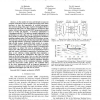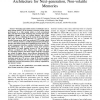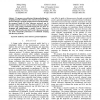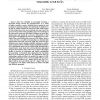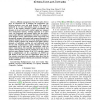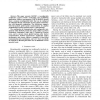106
click to vote
MICRO
2010
IEEE
14 years 10 months ago
2010
IEEE
As the number of cores and threads in manycore compute accelerators such as Graphics Processing Units (GPU) increases, so does the importance of on-chip interconnection network des...
123
click to vote
MICRO
2010
IEEE
14 years 10 months ago
2010
IEEE
Abstract--Many shared-memory parallel systems use lockbased synchronization mechanisms to provide mutual exclusion or reader-writer access to memory locations. Software locks are i...
109
Voted
MICRO
2010
IEEE
14 years 10 months ago
2010
IEEE
Emerging non-volatile memory technologies such as phase change memory (PCM) promise to increase storage system performance by a wide margin relative to both conventional disks and ...
96
Voted
MICRO
2010
IEEE
14 years 10 months ago
2010
IEEE
We propose an architectural design methodology for designing formally verifiable cache coherence protocols, called Fractal Coherence. Properly designed to be fractal in behavior, t...
109
click to vote
MICRO
2010
IEEE
14 years 10 months ago
2010
IEEE
Bias temperature instability, hot-carrier injection, and gate-oxide wearout will cause severe lifetime degradation in the performance and the reliability of future CMOS devices. Th...
108
click to vote
MICRO
2010
IEEE
14 years 10 months ago
2010
IEEE
Soft error reliability is increasingly becoming a first-order design concern for microprocessors, as a result of higher transistor counts, shrinking device geometries and lowering ...
81
Voted
MICRO
2010
IEEE
14 years 10 months ago
2010
IEEE
Efficient management of last level caches (LLCs) plays an important role in bridging the performance gap between processor cores and main memory. This paper is motivated by two key...
126
Voted
MICRO
2010
IEEE
14 years 10 months ago
2010
IEEE
This paper presents ReMAP, a reconfigurable architecture geared towards accelerating and parallelizing applications within a heterogeneous CMP. In ReMAP, threads share a common rec...
122
Voted
MICRO
2010
IEEE
14 years 10 months ago
2010
IEEE
To extend the exponential performance scaling of future chip multiprocessors, improving energy efficiency has become a first-class priority. Single-chip heterogeneous computing ha...
111
click to vote
MICRO
2010
IEEE
14 years 10 months ago
2010
IEEE
Abstract--Parallel programming is hard, because it is impractical to test all possible thread interleavings. One promising approach to improve a multi-threaded program's relia...
